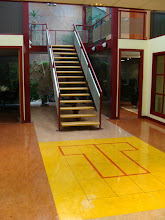lunes, 29 de febrero de 2016
LARTEC: UNESCO WORLD HERITAGE LIST
RESTAURACIÓN DEL LIENZO ESTE DE LA MURALLA DE ÁVILA. Hoy hemos presentado nuestra oferta técnica y económica. Durante 2 semanas he tenido la suerte de coordinar a un equipo internacional de expertos que considero insuperable en este momento. A las 12:40 de la mañana solo 5 empresas más habían presentado ofertas. Nuestra oferta está presentada por LARTEC, fundada en 1981 cuenta 35 años de experiencia en intervenciones sobre patrimonio arquitectónico, clasificación española K7-d (edificios históricos, Gobierno de España). Después de 5 años sin trabajar en España, LARTEC me ha dado la oportunidad de participar en un monumento incluido en la UNESCO World Heritage List: Old Town of Ávila with its Extra-Muros Churches. The city of Ávila is located in the centre of Spain, in the Autonomous Community of Castile and León. Founded in the 11th century to protect the Spanish territories from the Moors, this 'City of Saints and Stones' has maintained its medieval austerity, and is the birthplace of St Teresa and burial place of the Grand Inquisitor, Torquemada. This purity of form can still be seen in the Gothic cathedral and fortifications that, with their 87 semi-circular towers and nine gates, is the most complete found in Spain. The layout of the city is an even quadrilateral with a perimeter of 2,516 m. Its walls, which consist in part of stones already used in earlier constructions, have an average thickness of 3 m. Access to the city is afforded by nine gates of different periods; twin 20 m high towers, linked by a semi-circular arch, flank the oldest ones, Puerta de San Vicente and Puerta del Alcázar . The Old Town of Ávila is a serial property, which includes the walled town of Ávila and four extra-muros Romanesque churches: San Segundo, San Andrés, San Vicente, and San Pedro. In 2007, another three Romanesque churches (San Nicolás, Santa María de la Cabeza, and San Martín) and three convents from the 15th and 16th centuries (La Encarnación, San José and the Real Monasterio de Santo Tomás) were added to the inscribed property. The city of Ávila was registered as a “Historic Site” in 1982, and its walls have the classification of National Monument; furthermore, each one of the ten inscribed extra-muros churches are declared as Property of Cultural Interest (BIC, Bien de Interés Cultural), the highest level of protection according to the current Cultural Heritage Laws. Any intervention at the property, including archaeological investigation, requires prior administrative authorization, according to the current Cultural Heritage Laws (Law 12/2002, 11 July, of Cultural Heritage of Castile and León, Decree 37/2007, 19 April, that approves the Rules for the Protection of Cultural Heritage in Castile and León, Law 16/1985, 25 June, of Spanish Historic Heritage). The Commission for Cultural Heritage of Ávila must approve in advance all the projects concerning this site.
domingo, 28 de febrero de 2016
Gaza
No importa si la fotografía es casual o si es un montaje. Impresiona igual. El fotógrafo: Emad Samir (Gaza).
miércoles, 24 de febrero de 2016
Pobreza Voluntaria - Voluntary Poverty
John Pawson (Halifax, Inglaterra, 1949), arquitecto. Empezó sus estudios en la Architectural Association de Londres con más de 30 años de edad. Anteriormente había trabajado en la fábrica textil de su familia. El escritor Bruce Chatwin, a propósito de la obra de Pawson, sitúo su trabajo dentro de un movimiento que pudiéramos denominar "voluntary poverty". Un término que se ajusta a criterios conceptuales que comparto en este momento de mi vida y de mi trabajo.
martes, 9 de febrero de 2016
Philippe Halsman (1906-1979)
Jumping Style. Se trataba de retratar a la persona saltando, para así conseguir una imagen de ésta mucho más real, más verdadera, sin artificio ninguno, sin que el cerebro pudiera controlar la expresión del rostro. «En un salto, la máscara se cae. La persona real se hace visible», explicaba Halsman.
Suscribirse a:
Comentarios (Atom)


































































































